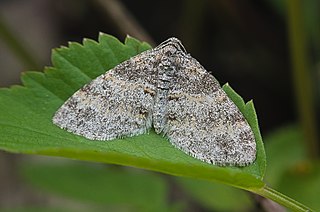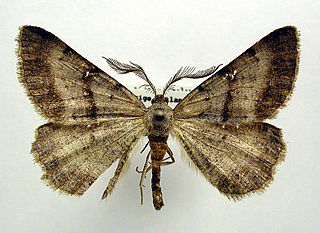
The clouded border is a moth of the family Geometridae. The species was first described by Carl Linnaeus in his 1758 10th edition of Systema Naturae. It is distributed across most of Europe to the Urals, western and central Siberia, Transbaikalia, Kazakhstan, Tian-Shan, northern Mongolia and parts of the Near East.

The mottled beauty is a moth of the family Geometridae. The species was first described by Carl Linnaeus in his 1758 10th edition of Systema Naturae.

The brimstone moth is a moth of the family Geometridae. The species was first described by Carl Linnaeus in his 1758 10th edition of Systema Naturae. It should not be confused with the brimstone butterfly Gonepteryx rhamni.

The brindled beauty is a Palearctic moth belonging to the family Geometridae.

Lobophora halterata, the seraphim, is a moth of the family Geometridae. It was first described by Johann Siegfried Hufnagel in 1767. The species can be found in central and northern Europe and a few localities in southern Europe, Siberia, Amur, Primorye, Sakhalin and Japan.

Pelurga comitata, the dark spinach, is a moth of the family Geometridae. It is found throughout the Palearctic, including Europe, Siberia, the Russian Far East and northern China

Agriopis aurantiaria, the scarce umber, is a moth of the family Geometridae. It was first described by Jacob Hübner in 1799 and it is found throughout Europe from Spain through Central Europe to Russia. In the south it can be found from the western Mediterranean to the Black Sea and the Caucasus. Its northern distribution reaches as far as central Fennoscandia. The species can be found in many different places, including deciduous forests, orchards, gardens as well as parks and settlement areas.

Coenotephria salicata, the striped twin-spot carpet, is a moth of the family Geometridae. It was first described by Michael Denis and Ignaz Schiffermüller in 1775 and is found in most of Europe.

Carsia sororiata, the Manchester treble-bar, is a moth of the family Geometridae. The species was first described by Jacob Hübner in 1813. It is found in northern and central Europe, the Urals, Siberia, the Far East, northern Mongolia and in North America from Alaska to Newfoundland and to New Hampshire.

Aspitates gilvaria, the straw belle, is a moth of the family Geometridae. The species was first described by Michael Denis and Ignaz Schiffermüller in 1775. It is found from Europe to the eastern part of the Palearctic realm. The main habitats are warm slopes, heathlands, fields and abandoned quarries. In the mountains, the species rises to heights of 1000 meters. Adults are on wing from July to August.

Earophila badiata, the shoulder stripe, is a moth of the family Geometridae. The species was first described by Michael Denis and Ignaz Schiffermüller in 1775. It is found from most of Europe and North Africa to the Altai Mountains in the east Palearctic.

Selidosema brunnearia, the bordered grey, is a moth of the family Geometridae. The species was first described by Charles Joseph Devillers in 1789. It is found in central and southern Europe, Asia Minor, Transcaucasia and North Africa.

Eois grataria is a moth in the family Geometridae. It is found in the Indian subregion, Sri Lanka, Hong Kong, Sundaland and on Christmas Island.
Eois nigriceps is a moth in the family Geometridae. It is found in Peru.
Eois nigrinotata is a moth in the family Geometridae. It is found in Peru.
Eois pallidicosta is a moth in the family Geometridae. It is found in Peru.
Eois perstrigata is a moth in the family Geometridae. It is found in Peru.
Eois planetaria is a moth in the family Geometridae. It is found in Peru.
Eois stellataria is a moth in the family Geometridae. It is found in Peru.
Eois vinosata is a moth in the family Geometridae. It is found in Peru and Ecuador.












